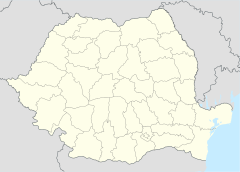Roşca-Buhaiova
| Roşca-Buhaiova | ||
|---|---|---|
| Largest pelican colony in Europe | ||
|
|
||
| Location: | Tulcea , Romania | |
| Next city: | Tulcea | |
| Surface: | 96.25 km² | |
| Founding: | 1940 | |
Roşca-Buhaiova is a protected area in nature and landscape protection of IUCN Category IV Biotope and Species Protection Area in the National Park Biosphere Reserve Danube Delta . It is located on the territory of the municipality of Chilia Veche , in the Tulcea district , in Romania .
description
The nature reserve Roşca-Buhaiova has been a nature reserve since 1940. It was designated a nature reserve of national importance by law number 5 of March 6, 2000 and court order number 2.151 of November 30, 2004 . As part of the National Park Danube Delta Biosphere Reserve, it is part of the World Heritage of UNESCO .
The Roşca-Buhaiova reserve extends to the north of the Danube Delta, southeast of Chilia Veche , in the Tulcea district and includes the lake complex between the Letea and Chilia sandbanks. With an area of 96.25 km², the protected area is the second largest strictly protected zone in the Danube Delta Biosphere Reserve after the Sakhalin-Zătoane lake complex.
fauna
The nature reserve Roşca-Buhaiova serves mainly to protect and preserve the largest pelican colony ( Pelecanus onocrotalus ) in Europe, which is home to other rare bird species such as spoonbills ( Platalea leucorodia ), herons ( Egretta ) and cormorants ( Phalacrocorax carbo ).
The animal world is also represented by mammals such as otters ( Lutra lutra ), minks ( Mustela lutreola ), ermines ( Mustela erminea ), muskrats ( Ondatra zibethicus ), foxes ( Vulpes vulpes ), wild boars ( Sus scrofa ) and the raccoon dog ( Nyctereutes procyonoides ) , also called Enok , represented.
flora
From the plant world, sea roses ( Nymphaea ) and pond roses ( Nuphar ), frog bites ( Hydrocharis morsus-ranae ), water hazel ( Trapa natans ) and some carnivorous plants ( carnivores ) are at home here.
In addition to willows ( Salix ) and poplars ( Populus ), reeds ( Phragmites australis ), rushes ( Juncaceae ), but also calamus ( Acorus calamus ), marsh ferns ( Thelypteridaceae ) and buttercups ( Ranunculus repens ) grow here .
See also
- List of nature reserves in Romania
- List of nature reserves in Tulcea County
- Danube Delta Biosphere Reserve
Web links
- Management plan of the Danube Delta Biosphere Reserve
- Rosca-Buhaiova
- Danube Delta Biosphere Reserve. Strictly Protected Zones
Individual evidence
- ^ Protected Areas of National Importance in Romania , Law No. 5 of March 6, 2000
- ↑ Nature reserves in Romania ( Memento of September 27, 2013 in the Internet Archive ) (PDF; 474 kB), court order No. 2.151 of November 30, 2004
- ↑ Rosca-Buhaiova , Info Delta Dunării
- ↑ a b c d e DDBRA: Plan de management , management plan for the administration of the Danube Delta Biosphere Reserve


